Bullock's Wilshire Building
Introduction
Text-to-speech Audio
The building with the soaring tower on Wilshire Boulevard across from the S. Westmoreland Ave. intersection was built from 1928 to 1929. The Art Deco style structure was originally Bullock's, a luxury department store. The branch store was the first department store to break away from the downtown shopping area. Designed by architects John and Donald Parkinson, the building is considered to be the best surviving example of Art Deco architecture in L.A. The Bullock's Wilshire Building was added to the National Register of Historic Places in 1978. The store closed in 1993 and Southwestern Law School soon acquired the building, its neighbor, and spent millions to restore the structure; the law school still occupies the building.
Images
Bullock's Wilshire in 2005 photo (Carol M. Highsmith)
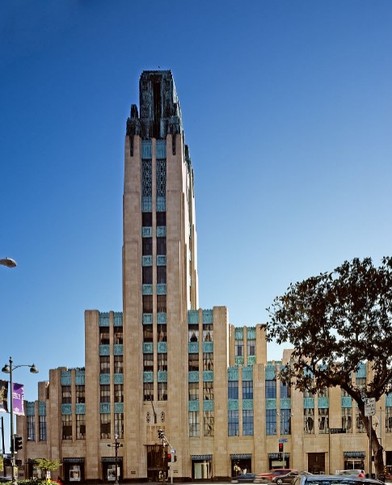
Bullock's Wilshire (white arrow) on 1932 tourist map of L.A. area (M.K. Leuschner)
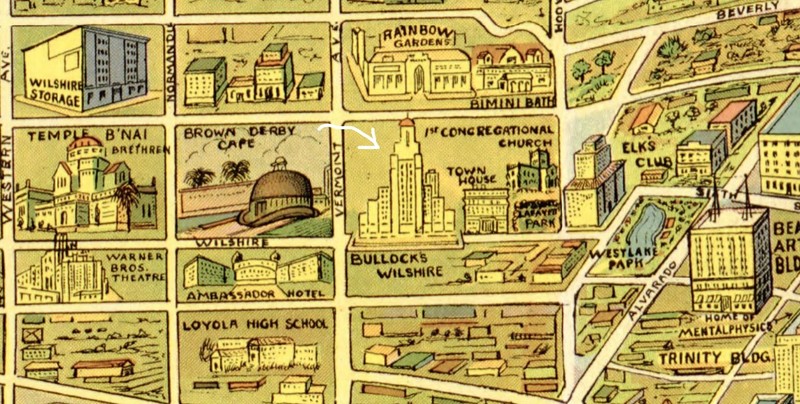
1977 view of north and east facades of Bullock's Wilshire (Tom Sitton for NRHP)
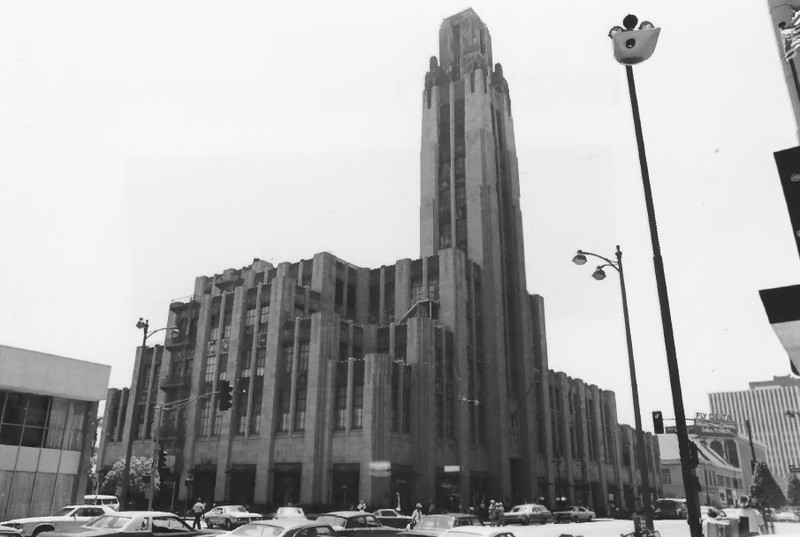
Measured drawing from photograph of north facade of Bullock's Wilshire (Jean Davis 1969 for HABS CA-1941)
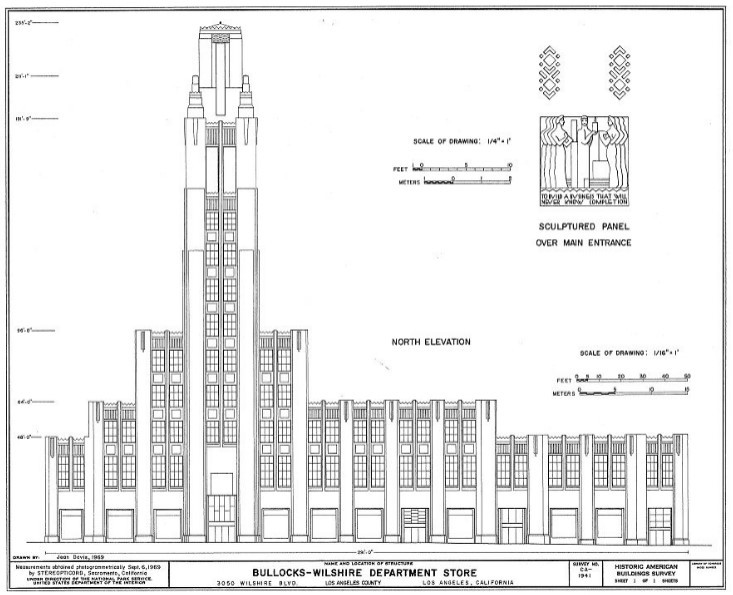
HABS measured sketch of sculptured panel above main entrance to Bullock's Wilshire (Davis 1969)
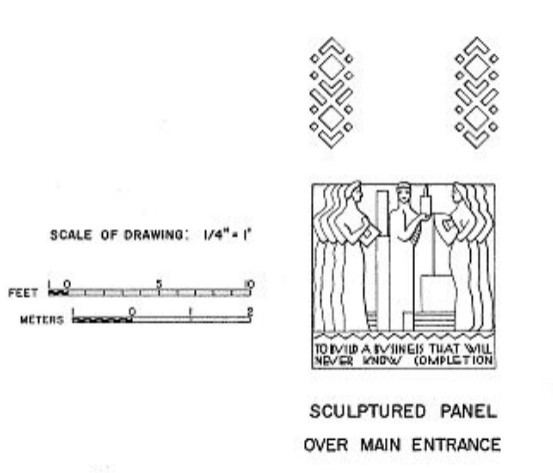
Backstory and Context
Text-to-speech Audio
The first Bullock's department store was situated in downtown Los Angeles, built for John G. Bullock at Seventh and Broadway around 1906. Bullock's Wilshire was the first department store in Los Angeles to establish a major branch outside the downtown area. Bullock was also the first to create a branch store in L.A. in competition with his existing downtown store. The opening of the branch of Bullock's on Wilshire Blvd. in 1929 marked the beginning of a second business district. Local newspapers called the building - designed by John and Donald Parkinson - a temple to merchandising.
Built from 1928 to 1929, the Art Deco style skyscraper on Wilshire became a popular place for tourists and a visual landmark west of downtown. The steel-framed structure covered in buff terra cotta and green (aged) copper featured graduated heights of two to four stories. The narrow tower of six stories was extended to nine stories by a copper-sheathed extension. The building's exterior's marked vertical lines are typical of many Art Deco buildings. Geometric, angular decorative elements are another hallmark of this style. Along the parapet is copper work with a jagged, zig-zag pattern; decorative copper spandrels mark the spaces between upper stories. Ground floor display window casings and sun awnings have geometric designs.
When the building was documented in the 1970s for listing in the National Register, it was still a Bullock's department store. Most of the exterior was unchanged except for a mural by Herman Sachs on the motor court side; the painting, on the history of transportation, was touched up in 1973 by a Heinburgan. Also, in 1953, a three-story addition was built on the south side of the structure, filling in a U-shaped courtyard. The interior foyer of Bullock's had marble walls; interior flooring was of marble, travertine, or linotile; some walls were covered in rose marble. The elevator doors were a combination of copper, brass, and gunmetal. Display cases were manufactured of expensive materials - English laurel and rosewood. The Tea Room's ceiling was decorated by a painted glass ceiling by Herman Sachs. A sculpture named "The Spirit of Sports" by Gjura Stojano hung in the Sportshop.
After this store closed in 1993 amid bankruptcy, Federated Department Stores (the parent company of Bullock's and Macy's by then) stripped the structure of many of its details. After a lawsuit, many of the elements were returned to the building, including its crystal chandeliers. A neighbor from across the street, Southwestern Law School, acquired the former Bullock's building in 1994. Southwestern restored the structure over the next decade with a cost of $29 million. The 83,000-square foot law library in the restored building opened in 1997. The law school still owns and occupies the building.
Cite This Entry
Paonessa, Laurie. "Bullock's Wilshire Building." Clio: Your Guide to History. May 4, 2023. Accessed March 26, 2025. https://theclio.com/entry/167587
Sources
Gray, Pamela Lee. NRHP nomination of Bullock's Wilshire Building, 3050 Wilshire Boulevard, Los Angeles, California. National Register. Washington, DC. National Park Service, 1977.
Silverman, Eleni. Geibner, Robert C. HABS documentation of Bullock's-Wilshire Department Store, Los Angeles, California. Volume HABS CA-1941. Historic American Buildings Survey. Washington, DC. U.S. Department of the Interior, 1984.
Southwestern Law School. History of Bullocks Wilshire, Southwestern Law School. January 1st, 2023. Accessed May 4th, 2023. https://www.swlaw.edu/bullocks-wilshire-campus/bullocks-wilshire-building/history-bullocks-wilshire.
Highsmith Collection, LOC: https://www.loc.gov/item/2006675247/
LOC: https://www.loc.gov/item/2006626011/
National Park Service (NPS): https://npgallery.nps.gov/AssetDetail/NRIS/78000685
LOC: https://www.loc.gov/item/ca0213/
LOC: https://www.loc.gov/item/ca0213/

